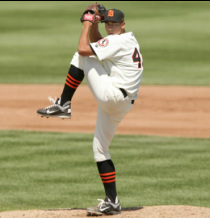 Reds RHP, Robert Stephenson Over the coming days, I will begin to unveil my Top 50 prospects in baseball. I will release ten players each day until I get to the Top 10 prospects. Each player has a small scouting report that describes his skills and shortcomings. After releasing the Top 50, I will post a full list of my Top 100 prospects (albeit without scouting reports) as well as my current farm system rankings for each MLB Franchise. This is not a science, and not all prospects listed here will make the major leagues. However, these players were selected for both their overall potential and their likelihood of reaching it, as seen in my choices. Furthermore, here are some terms you should be familiar with before reviewing the upcoming lists. 20-80 scouting scale: Scale used to judge a player and his "tools" or attributes. 50 is major league average, 60 is above average or "plus", 70 is well above average or "plus-plus", and 80 is reserved for the absolutely best tools or players in the game (elite) Ceiling: Refers to a player's maximum potential; Although highly desired in prospects, ceilings are very rarely achieved and often fall short for a number of things. ETA: Estimated Time of Arrival Feel: Ability for a pitcher to throw a pitch with ease and be able to locate it frequently. Life: Action on a particular pitch, usually describing a fastball's late movement Makeup: Broad term that includes leadership ability, baseball IQ, work ethic, and ability to respond and adjust to failure (it will happen!) Rawness: A term used to describe a player who lacks consistency and has yet to fully develop his talents Run: Armside movement on a particular pitch Tools: A player's set of skills; describe a player's ability to hit, hit for power, run, throw, and field Any other scouting terms you may be unfamiliar with, just contact me and I add them to this page or the glossary. Additionally, if you are confused about why a particular prospect is ranked higher than another, I will be more than happy to explain my reasoning to you. So, without further delay, here are my 50-41 best prospects in Major League Baseball... 50. Casey Kelly , SP, San Diego Padres, ETA: 2013: Former Red Sox prospect experienced some injuries in 2012, but that did not stop him from making his ML debut. Kelly's repertoire includes a good sinker and change up that he can command frequently, a skill set that could lead him to being a traditional middle of the rotation workhouse 49. Austin Hedges , C, San Diego Padres, ETA: 2015: Arguably the best defensive catcher already in the minors, Hedges combines his defensive chops with surprising ability with the bat. He could be a .270-.275 hitter with 15 HRs annually and be similar to the pre-2011 Yadier Molina. Also possesses a strong leadership ability and is lauded for his makeup from behind the plate. 48. Gregory Polanco , OF, Pittsburgh Pirates, ETA: 2015: Talented outfielder that showed ability to hit for average, power, run, throw, and field in his breakout season. Still raw in most parts of the game, but his potential is salivating to a team that has had 20 consecutive losing seasons. 47. Trevor Story , SS/3B, Colorado Rockies, ETA: 2015: Rockie farmhand has solid tools all around, which will play up if he stays at shortstop. Good hit tool, decent power, and average defense should play at ML level, even if a move to third is deemed necessary (Tulowitzki roadblock in Colorado). 46. Robert Stephenson , SP, Cincinnati Reds, ETA: 2015: 2011 first round pick that flashed his huge potential with a monster fastball and advanced change up. Stephenson also showed the ability to throw strikes a solid rate and has a high baseball IQ. Has a very promising future but rawness could take some time to iron out. 45. Mason Williams , OF, New York Yankees, ETA: 2015: Toolsy outfielder has the ability to hit for average and play good defense in CF. As he continues to mature his approach at the plate, he could tap into some more power (only 8 HRs in 2012) and add to his already promising offensive repertoire. 44. Jorge Soler , OF, Chicago Cubs, ETA: 2015: The other Cuban import has as much talent as his countryman (Yoenis Cespedes) but is more raw. Soler has huge power potential and his plus plus bat speed provides drives to all fields. He also has an excellent arm that could make him a prototypical rightfielder. 43. Taylor Guerrieri , SP, Tampa Bay Rays, ETA: 2015: The latest power arm to come through the Rays system is Guerrieri with the potential to have four above average pitches (fastball, curve, change, and cutter) along with plus plus control. Only reason he is this low is because he was pitched cautiously (only 52 innings) and plenty can still go wrong from short season ball to the majors. 42. Alex Meyer , SP, Washington Nationals, ETA: 2014: Nasty stuff comes from the Kentucky product's right arm, but his inconsistent delivery (influenced by his 6'9" frame) can lead to occasional bouts of wildness. Power fastball with good sink and a sharp breaking ball should at least take him to the majors as a dominant reliever. 41. Jedd Gyorko , 3B/2B, San Diego Padres, ETA: 2013: Simply, Gyorko is a hitter first, everything else second. Gyorko consistently barrels up ball and is a true plus plus hitter. Lack of a defensive home with a current roadblock at 3B (Chase Headley), Gyorko could profile as an all bat/no glove second baseman (a la Dan Uggla).
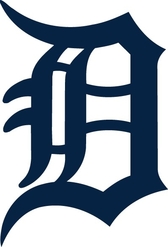 Nick Rabasco:
Game 1: Tigers 4 - Giants 2
Game 2: Tigers 3 - Giants 6
Game 3: Giants 4 - Tigers 5
Game 4: Giants 2- Tigers 1
Game 5: Giants 0 - Tigers 3
Game 6: Giants 3 - Tigers 4
2012 World Series Champion: Detroit Tigers
WS MVP: Justin Verlander
Notes: I predict a fairly low scoring series due to the strength of both pitching staffs. Also, the Tigers pitching staff was lights-out in the ALCS and I have Justin Verlander turning in two more masterpieces in games 1 and 5 on his way to MVP. Although the trio of Matt Cain, Barry Zito and Ryan Vogelsong had great outings in NLCS elimination games, I believe the tigers offense led by Austin Jackson, Miguel Cabrera and Prince Fielder is enough to get by.
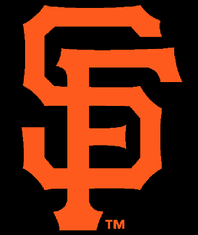 Aidan Flynn:
Game 1: Tigers 7 - Giants 0
Game 2: Tigers 2 - Giants 5
Game 3: Giants 1 - Tigers 3
Game 4: Giants 2 - Tigers 1
Game 5: Giants 0 - Tigers 6
Game 6: Tigers 2 - Giants 6
Game 7: Tigers 3 - Giants 5
2012 World Series Champion: San Francisco Giants
WS MVP: Angel Pagan
Notes: As shown above, I fully expect the Giants to win their 7th World Series championship and bring the title back to the city of San Francisco. I believe that the Giants offense is quite underrated (highest OPS+ in NL) due to the offensive suppression caused by AT&T Park. In my opinion, the Giants' lineup presents a more balanced attack compared to the top-heavy lineup of the Tigers. Additionally, I have more faith in the Giants pitching than that of the Tigers (except when countering Tigers' ace Justin Verlander, of course) due to their consistency of their bullpen. This will help they conserve victories in the close games where the Tigers' bullpen cannot. Either way, baseball is a sport where anything can happen, with this postseason being no exception. Boy, do I love baseball!
As the 108th World Series is about to kick off, we here at BTP wish to unveil our first annual Behind the Plate Award Winners, in honor of each player's tremendous season. We carefully selected each player after much conversation and debate, trying to ensure we selected the most deserving candidates. Many of our awards derive their names from the players that best exhibited what each award represents. A short description for each award is as follows:
Best Player Award: Pretty self-explanatory, we wanted to remove the term "valuable," as it can be interpreted several different ways.
Walter Johnson Award: Named after arguably the greatest pitcher of all-time, this award is presented to the pitcher who had the best season in his respective league.
Babe Ruth Award: Named after arguably the greatest hitter of all-time, this award is presented to the hitter who had the best season in his respective league.
Mariano Rivera Award: Named after arguably the greatest relief pitcher of all time, this award is presented to the reliever who had the best season in his respective league.
Mike Trout Award: Named after the player who arguably completed the greatest rookie season of all time, this award is presented to the rookie who had the best season in his respective leagve.
Connie Mack Award: Named after the winning-est manager in Major League history, this is presented to the best manager in his respected league.
Branch Rickey Award: Named after one of the most innovative and influential executives in Major League history, this is presented to the executive that made the best transactions toward improving his club for the 2012 season.
And without further adieu...
Best Player Award:
American League: Mike Trout, OF, Los Angeles Angels of Anaheim
National League: Buster Posey, C, San Francisco Giants
Walter Johnson Award:
American League: Justin Verlander, Detroit Tigers
National League: R.A. Dickey, New York Mets
Babe Ruth Award:
American League: Miguel Cabrera, 3B, Detroit Tigers
National League: Buster Posey, C, San Francisco Giants
Mariano Rivera Award:
American League: Fernando Rodney, Tampa Bay Rays
National League: Craig Kimbrel, Atlanta Braves
Mike Trout Award
American League: (Surprise!) Mike Trout, OF, Los Angeles Angels of Anaheim
National League: Bryce Harper, OF, Washington Nationals
Connie Mack Award:
American League: Buck Showalter, Baltimore Orioles
National League: Davey Johnson, Washington Nationals
Branch Rickey Award:
American League: Billy Beane, Oakland Athletics
National League: Mike Rizzo, Washington Nationals
All BTP 1st Team:
C: Buster Posey, San Francisco Giants
1B: Prince Fielder, Detroit Tigers
2B: Robinson Cano, New York Yankees
3B: Miguel Cabrera, Detroit Tigers
SS: Ian Desmond, Washington Nationals
OF: Mike Trout, Los Angeles Angels of Anaheim
OF: Ryan Braun, Milwaukee Brewers
OF: Andrew McCutchen, Pittsburgh Pirates
DH: David Wright, 3B, New York Mets
SP: Justin Verlander, Detroit Tigers
SP: R.A. Dickey, New York Mets
SP: Clayton Kershaw, Los Angeles Dodgers
SP: David Price, Tampa Bay Rays
RP: Fernando Rodney, Tampa Bay Rays
RP: Craig Kimbrel, Atlanta Braves
RP: Aroldis Chapman, Cincinnati Reds
All BTP 2nd Team:
C: Yadier Molina, St. Louis Cardinals
1B: Joey Votto, Cincinnati Reds
2B: Aaron Hill, Arizona Diamondbacks
3B: Chase Headley, San Diego Padres
SS: Derek Jeter, New York Yankees
OF: Matt Holliday, St. Louis Cardinals
OF: Austin Jackson, Detroit Tigers
OF: Josh Hamilton, Texas Rangers
DH: Adrian Beltre, 3B, Texas Rangers
SP: Johnny Cueto, Cincinnati Reds
SP: Gio Gonzalez, Washington Nationals
SP: Felix Hernandez, Seattle Mariners
SP: Chris Sale, Chicago White Sox
RP: Kris Medlen, Atlanta Braves
RP: Jim Johnson, Baltimore Orioles
RP: Sergio Romo, San Francisco Giants
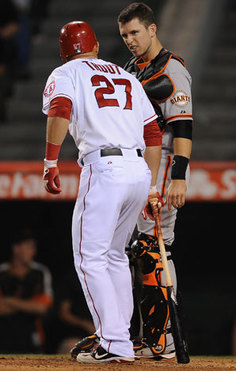 Mike Trout and Buster Posey took home the most BTP Awards
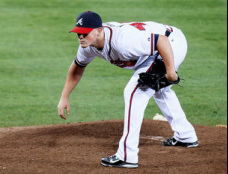 Is the "save" what it used to be? Nasty does not begin to describe the stuff Aroldis Chapman and Craig Kimbrel possess. The two young fireballers have turned into two of the most dominant relief pitchers in all of baseball. Notice I said “relief” pitchers, not closers. Although technically they are perceived as closers, they should not be used in the ninth inning exclusively to “close” out games. Kimbrel is leading the National League in strikeouts per nine innings (K/9), while Chapman is right behind him at 16.35 K/9 and 15.60 K/9 respectively. So, if your team has a one run lead in the 7th inning with the bases loaded and 1 out, why would a manager not go to his best strikeout guy? This is because of the save statistic and the fact that closers are defined by how many saves they can record. Nowadays, you see a closer, someone who is generally regarded as the team’s best reliever, come into a game more often when the team has a 3 run lead at the start of the ninth inning. The amount of pressure in these situations is drastically different. One way to measure different pressure situations is with leverage index. Leverage index determines the weight of a particular situation due to the inning, score, and outs present at the time. This simplifies pressure-packed or pressure absent at a certain point during the game. For example, the leverage index for a reliever coming in the bottom of the ninth with nobody on and nobody out with a three run lead is 1.0, or in other words, a low leverage situation. On the other hand, a bases loaded, down two, nobody out scenario in the 7th assigns a high leverage number of 4.1. "Firemen" like Chapman and Kimbrel should be used when the pressure is at its highest point in the game. Yes, more often than not, this situation arises before the ninth inning, often representing the turning point of a ball game. However, some teams have done a better job of maximizing their pitcher's ability in pitching higher leverage circumstances. Guys like Fernando Rodney of Tampa Bay and Jim Johnson of Baltimore have emerged as the game’s best relievers and have become poster children for pitching with increased pressure. For example, Johnson leads the league in games entered with high leverage present (leverage index greater than 1.5). On the other hand, Rodney leads all relievers in situational wins saved, a computation of win probability added divided by the leverage index or pressure at a given time. Also, both pitchers rank in the top ten in terms of pitching with high leverage index. In other words, they have pitched the most in pressured packed situations. By maximizing a pitcher's ability and bringing him when the "fire" is its hottest, teams are better able to preserve and secure victories. Again, it is not a coincidence that these teams are either in the playoffs or were in contention until the last week of the season (Tampa Bay). Clearly, pitchers that can come in and shutdown a rally or strikeout somebody out when necessary is crucial to any team’s success. A shutdown or meltdown would be a better way to look at a reliever’s success rather than just look at the save statistic. Shutdowns and meltdowns offer an alternative to the save statistic by simply analyzing whether a pitcher helped or hurt his teams' chances of winning. If a pitcher improved his team's chances of winning by at least 6%, he gets a shutdown. If he hurts his team's chances by 6% or more, then he is awarded a meltdown. This has no silly rules (rule 10.19) to follow and treats all relief pitchers equally (instead of favoring closers like the save statistic implies). Not surprisingly, the aforementioned “closers” have some of the best shutdown ratios in the league (Kimbrel: 37 SD, 4 MD, Chapman: 41 SD, 6 MD, Johnson: 46 SD, 3 MD, Rodney: 34 SD, 2 MD). Yet, even with these excellent numbers, it does not necessarily mean that pitchers are capitalizing on their talent. Would you rather have a middle relief journeyman pitching in a high leverage situation, or a talented flamethrower capable of getting a much needed strikeout? I think the answer is quite obvious and just further illustrates why the current status quo must be changed.
Nick Rabasco: NL Wild Card: Braves over Cardinals
AL Wild Card: Orioles over Rangers
NL Divison Series: Giants over Reds
Nationals over Braves
AL Division Series: Tigers over A's
Orioles over Yankees
NL Championship Series: Nationals over Giants
AL Championship Series: Tigers over Orioles
World Series: Tigers over Nationals
2012 World Champion: Detroit Tigers
Aidan Flynn: NL Wild Card: Cardinals over Braves
AL Wild Card: Rangers over Orioles
NL Division Series: Reds over Giants
Cardinals over Nationals
AL Division Series: Rangers over Yankees
Tigers over A's
NL Championship Series: Reds over Cardinals
AL Championship Series: Rangers over Tigers
World Series: Reds over Rangers
2012 World Champion: Cincinnati Reds
|





 RSS Feed
RSS Feed